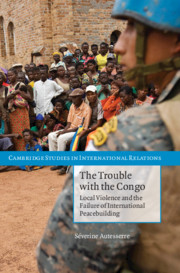Book contents
- Frontmatter
- Contents
- List of Figures and Tables
- Glossary of Acronyms, Names, and Ethnic Terms
- 1 Map of the Democratic Republic of the Congo and Its Neighbors
- Preface and Acknowledgments
- 1 The Peacebuilding World
- 2 A Top-Down Problem
- 3 A Top-Down Solution
- 4 A Bottom-Up Story
- 5 The Defeat of Bottom-Up Solutions
- 6 Beyond the Congo
- Appendix: Chronology
- Bibliography
- Index
- Cambridge Studies in International Relations
4 - A Bottom-Up Story
Published online by Cambridge University Press: 05 June 2012
- Frontmatter
- Contents
- List of Figures and Tables
- Glossary of Acronyms, Names, and Ethnic Terms
- 1 Map of the Democratic Republic of the Congo and Its Neighbors
- Preface and Acknowledgments
- 1 The Peacebuilding World
- 2 A Top-Down Problem
- 3 A Top-Down Solution
- 4 A Bottom-Up Story
- 5 The Defeat of Bottom-Up Solutions
- 6 Beyond the Congo
- Appendix: Chronology
- Bibliography
- Index
- Cambridge Studies in International Relations
Summary
A disconnect frequently surfaced between the international peacebuilders' statements on the security situation in the eastern Congo and the events unfolding on the ground. On May 26, 2004, I attended a large meeting with U.S. diplomats, donors, and humanitarian actors based in South Kivu, at which everyone concluded that the province was relatively calm, except for pockets of tension in the northern and southern sections. All present agreed that the city of Bukavu, where the meeting took place, was once again stable and uneventful. A few hours later, large-scale fighting broke out in Bukavu and quickly spread to the entire province, almost causing a collapse of the national and regional peace settlements.
U.S. and humanitarian actors were not the only ones to err in their judgment. In December 2004, at the height of another major bout of fighting in the eastern provinces, the Belgian foreign minister claimed that the situation was “within reach of stabilization, of peace.” In May 2005, while the population of the eastern provinces lived in fear of recurring massacres, a United Nations (UN) spokesperson claimed that “overall, the situation was now well under control, but still remained quite hostile.” In June 2005, another UN spokesperson claimed that the security situation was “progressively returning to normal,” notwithstanding the fact that, two weeks prior, UN troops had engaged in a massive “four-hour gun battle with militiamen” and that, two weeks later, UN forces and militias fought for more than eight hours.
- Type
- Chapter
- Information
- The Trouble with the CongoLocal Violence and the Failure of International Peacebuilding, pp. 126 - 178Publisher: Cambridge University PressPrint publication year: 2010

